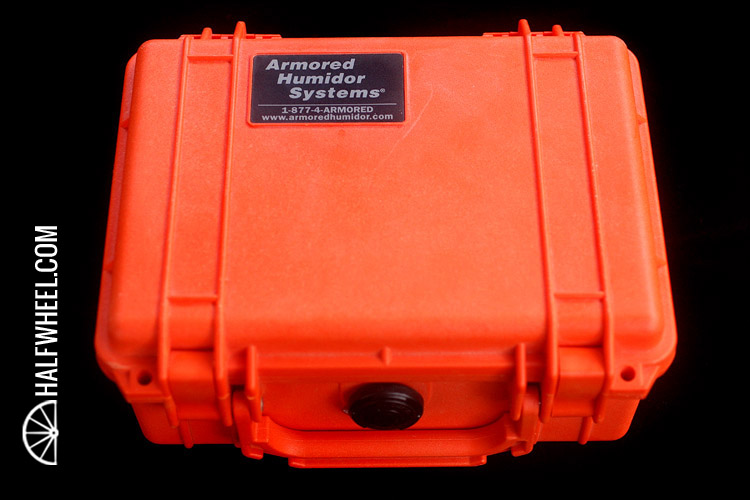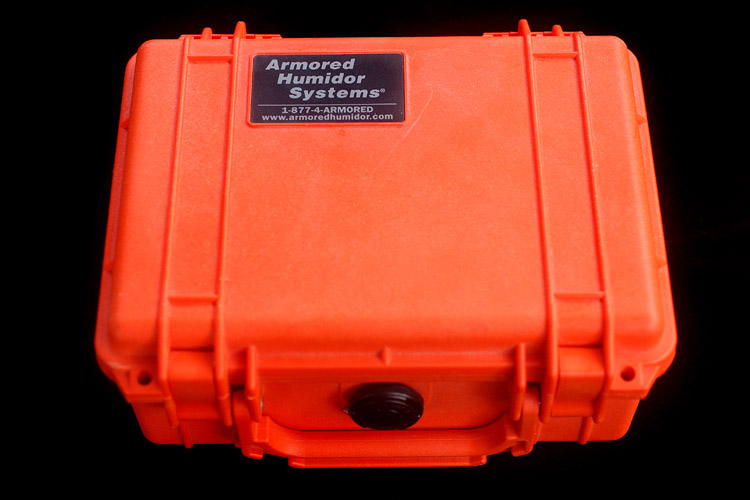Armored Humidor Systems has been around for years, but in 2010 the business was purchased by Jeff Haugen, who also owns site sponsor Tobacco Grove and is now updating the brand.
All Armored Humidors use genuine Pelican cases. In case you are unfamiliar with Pelican, the company’s press line reads:
Pelican Products, Inc. is the global leader in design and manufacture of both high-performance case solutions and advanced portable lighting systems. Their products are used by professionals in the most demanding markets including firefighters, police, defense / military, aerospace, entertainment, industrial and consumer. Pelican™ products are designed and built to last a lifetime. The company operates in 12 countries, with 22 offices and six manufacturing facilities across the globe.
Pelican has been making their trademark solid protective cases for decades including some of my best photography cases. Armored Humidor Systems retrofits the interior of the cases with foam configurations made for cigars. Recently, Armored Humidor has added some of Pelican’s smaller and lighter cases to their line of products.


Here are the specifications of Armored Humidors from their website:
Armored Humidor uses only high quality cases from Pelican. All of these cases have undergone, and passed, rigerous defense standard testing. No other travel humidor company makes this claim, so when you purchase an Armored Humidor, you can be sure that you’ve made purchase that will last you a lifetime!
STANAG 4280 – DEF STAN 81-41 Tested by WYLE LABORATORIES Inc.
Vibration Test K DEF STAN 81-41: At 25ºC, 2 hours of vibration at amplitude of ± 0.23” (± 6 mm) peak (0.46” DA) from 5 to 9 Hz and ± 2 g peak from 9 to 350 Hz and a sweep rate of 0.75±0.25 octave.
Low Temperature Test G DEF STAN 81-41: Decrease temperature to -20±2ºC for 16±5 hours and afterwards return to 20±10ºC.
Dry Heat Test C DEF STAN 81-41: Increase temperature from 25±10ºC to 55±2ºC, humidity not exceeding 75%, and maintain conditions for 48±1 hours. Return temperature to 20±10ºC.
Impact Vertical Test E DEF STAN 81-41: At 25±10ºC, the case is dropped from a height of 1000±5 mm making sure that the impact is received in all angles of the case.
IP67 Water Resistance: With IP (Ingress Protection) ratings the first numeral refers to the level of dust resistance and the second numeral refers to the level of water resistance. The range IP67 rating means that the device is totally protected from dust and can be submerged in water to 1 m (3ft) for up to 30 minutes without any leakage. The ratings were set by the International Electro technical Commission.

There are six different models* of Armored Humidors. They are:
- Sport — Two trays holds up to six cigars (two trays with three slots each) — $38.98
- P-08 — Two trays holds up to eight cigars (two trays with four slots each) — $39.95
- P-12 — Two trays holds up to 14 cigars (one tray with five slots and one tray with nine slots) — $69.95
- P-15 — Three trays holds up to 15 cigars (three trays with five slots each) — $59.95
- P-18 — Three trays holds up to 18 cigars (three trays with six slots each) — $79.95
- P-24 — Four trays holds up to 24 cigars (four trays with six slots each) — $89.95
*There is also a “Camo” model of the P-18, which features the tree camo finish, comes with a knife included, and is limited to 100 units.
Like most travel humidors, the Armored Humidors are not overly difficult to figure out. You open it up, put your cigars in, close it and pick it up. Each model has a different layout of inserts and a different number of cigars that can be held in it. For example, the P-15, the model which is photographed, can hold 15 cigars in three foam trays of five cigars each.
Each of the Armored Humidors has the same solid finish, locking mechanism and handle, other than the new Sport model, which has a clear top, different colored bottoms and no handle.
As for humidification, a Boveda pack fits nicely underneath the bottom foam insert or inside the top of the foam in the lid.

I did two different tests with these humidors: a temperature/humidity test and an endurance test.
- For the temperature/humidity test, I put some cigars in a P-15 model, along with a hydrometer and a large Boveda 65% pack and left it in my garage for one week, checking the readings at different times throughout each day. While the temperature fluctuated a bit (about five degrees up or down, depending on the time of day), the humidity stayed an almost rock solid 64%-65% every time. There is absolutely no problem with the seal on these. The Armored Humidor Systems come with a smaller Boveda pack.
- For the endurance test, I decided to throw the case around a bit. So I took it to the middle of my street outside my house and kicked it around for a good 10 minutes. Then I gave it to my 16 month old to throw around and drool on. Then I submerged it in the bathtub while giving my son a bath (bubbles and all). After all that I checked the cigars, and they were in perfect shape as I expected. And here’s a video from Armored Humidor showing one of their humidors being run over by a 4 x 4:
THE COMPETITION
There are several other travel humidors that are sold under various names, including Cigar Caddy, XIKAR, The Sherman and the higher-priced Zero Haliburton. While the former three all use Pelican-like cases, none specifically acknowledge that their cases are genuine Pelican-cases, although it would appear given the marketing material that The Sherman uses genuine Pelican cases.
THE GOOD
- These are impeccably built, obviously built to last and solid to the touch. There are no problems keeping your cigars in perfect condition, no matter what you throw at it.
- Every single piece of each Armored Humidor is made in America, from the hinges to the printed sheet inside.
- The seal is watertight.
- There are plenty of options for sizes, colors and inserts.
- The pressure/vacuum release system works perfectly and I am not sure how people get by without it, when traveling on planes. Charlie actually keeps a Butane Screw Thing attached to his 15 count XIKAR travel humidor solely to pry the humidor open after traveling on planes.
- They are guaranteed for life. If you somehow manage to break it, they will send you another one. In fact, they only thing they ask for in return other than the humidor is an explanation on how you managed to break it.
- The use of genuine Pelican cases allows for a lot of customization by Armored Humidor in terms of appearance.
THE BAD
- Price seems a bit more expensive when compared to its closest competitor.
- Armored Humidor Systems are limited to up to 24 count configuration, lower than all of its competitors. In fairness, I haven’t been on many trips where I remember needing 24 cigars.
- The ends of the rows of the inserts are open ended, so cigars tend to slide back and forth if you turn the humidor around. For larger cigars, they stay fit, but if the cigars are smaller they do roll around a bit.
- They are just a little heavy, due to the protection that is given.

The Bottom Line: When I take my cigars anywhere, I want my travel humidor to do two things: keep my cigars fresh and keep them in perfect condition. As far as I am concerned, Armored Humidors are the best travel humidors in the world when you take into account price, quality, construction and availability. Yes, they are a bit expensive, although there is not as much of a difference in price as you would think between it and their cheaper competitors, but you only have to buy one, as opposed to multiples of the lesser brands as I did many times before I found these. Buy one and you will never need to replace it. For the most part, I use cheap cutters and cheap lighters, but my travel humidor is one thing I never screw around with.
If you are looking to purchase any of the Armored Humidor Systems models, site sponsor Tobacco Grove carries the full line.



